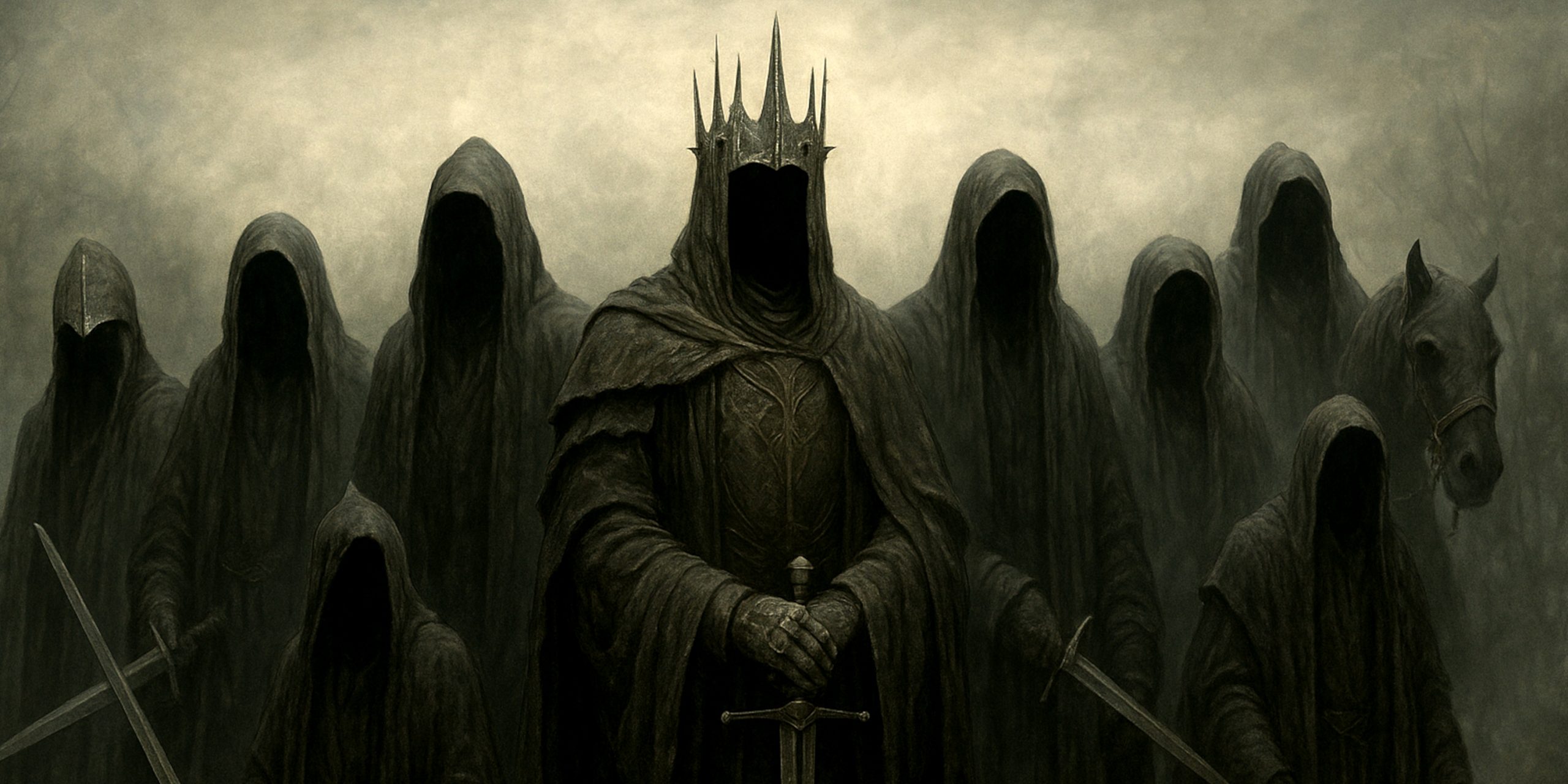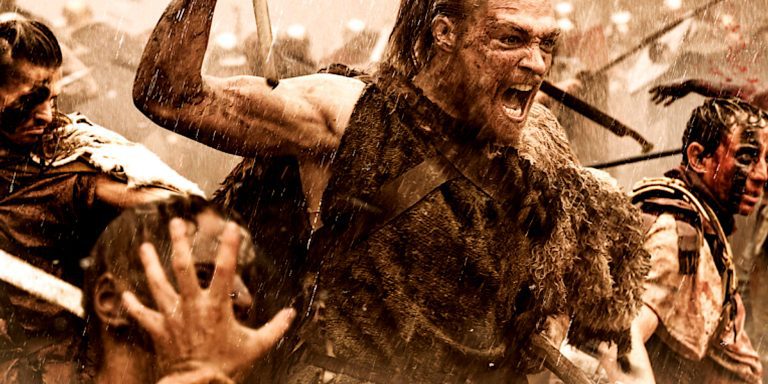
The Nine Ringwraiths, or Nazgûl, were once kings, lords, and sorcerers of Men who accepted Rings of Power from Sauron. The Rings granted them immense power and long life, but at a terrible cost. Over centuries, they faded into shadows, bound eternally to the will of the One Ring. Tolkien gave us very few names, and much of what we know comes from fragments in his writings and later scholarship.
1. The Witch-king of Angmar
- Role: Lord of the Nazgûl and Sauron’s chief servant
- Origins: Possibly a Númenórean prince or sorcerer
- Achievements: Founded the kingdom of Angmar in the north during the Third Age, leading devastating wars against Arnor
- Downfall: Slain at the Battle of the Pelennor Fields by Éowyn and Merry, fulfilling Glorfindel’s prophecy that no man would kill him
The Witch-king is the most powerful and most detailed of the Nine. His skill in sorcery and military command marks him as one of the greatest enemies of free Men.
2. Khamûl the Easterling
- Role: Second-in-command of the Nazgûl
- Origins: An Easterling lord, likely from Rhûn
- Titles: The Black Easterling, Shadow of the East
- Abilities: Could sense the presence of the One Ring more strongly than any other Nazgûl, though he was weaker in daylight
- Notable Acts: Governed Dol Guldur for Sauron during the late Third Age
Khamûl is the only other Nazgûl named directly by Tolkien, making him vital to piecing together the identity of the Nine.
3. The Númenórean King (Theory)
Several scholars suggest that at least one of the Nine was a Númenórean ruler. Númenórean pride and their eventual corruption made them natural targets for Sauron’s gifts. Such a figure may have ruled a coastal kingdom or colony in Middle-earth before falling under the Ring’s spell.
4. The Black Númenórean (Theory)
Another likely candidate is a Black Númenórean lord. The Black Númenóreans were descendants of Númenóreans who turned to Sauron and his dark teachings. Their ambition and lust for dominion made them prime candidates to bear a Ring.
5. The Haradrim King (Theory)
One of the Nazgûl may have been a ruler among the Haradrim. These southern kingdoms were powerful, and Sauron had longstanding influence over them. The presence of Mumakil and Haradric forces in his armies suggests that at least one Ringwraith came from this region.
6. The Easterling Warlord (Theory)
Besides Khamûl, it is possible that another Nazgûl came from the East. The Easterlings were repeatedly drawn to Sauron’s side in battle, and having more than one Nazgûl from their people would have helped secure their allegiance.
7. The Sorcerer-Lord (Theory)
Tolkien hints that some of the Nine were not merely kings but sorcerers. Such a figure could have come from Rhûn, Harad, or Númenórean colonies, wielding both political and magical power before succumbing to Sauron.
8. The Priest-King (Theory)
Some scholars suggest one of the Nazgûl was a religious figure, perhaps a high priest of a cult devoted to Melkor or Sauron. The Rings would have given him divine authority over his followers, making his corruption especially devastating.
9. The Forgotten Kings
The final Nazgûl are left entirely unknown. They may have been minor kings of Men whose names were never recorded, or rulers of distant lands beyond Gondor and Arnor’s knowledge. Their anonymity is part of Tolkien’s design: they stand not as individuals, but as symbols of the fate of Men who pursued power without restraint.
Why So Few Names Are Known
Tolkien deliberately withheld the identities of most of the Ringwraiths. By erasing their individuality, he underscored their loss of humanity. Once rulers of Men, they became faceless extensions of Sauron’s will, feared not for who they were, but for what they had become.
Legacy of the Nine
The Nazgûl symbolise the danger of ambition and the corrupting nature of power. Their fall serves as a warning within Tolkien’s wider themes: even the mightiest of Men can be enslaved when they grasp for immortality or domination.
The Nine Ringwraiths: Known and Theorised Origins
| Title/Name | Confirmed by Tolkien? | Possible Origin | Known Traits and Role | Notes |
|---|---|---|---|---|
| Witch-king of Angmar | Yes | Likely Númenórean or High King of Men | Lord of the Nazgûl, sorcerer, commander of Angmar, slain at Pelennor Fields | Most powerful of the Nine |
| Khamûl the Easterling | Yes | Easterling (Rhûn) | Second-in-command, called the Black Easterling, weaker in daylight, strong in sensing the Ring | Governed Dol Guldur |
| Númenórean King (theory) | No | Númenor or its colonies | Likely a ruler of a coastal or colonial kingdom | Fits Tolkien’s note that some were Númenóreans |
| Black Númenórean (theory) | No | Black Númenórean nobility | Ambitious lord who turned to Sauron | Known to have served Sauron in other ages |
| Haradrim King (theory) | No | Harad (southern realms) | Possibly ruled over tribes with Mumakil | Explains Haradrim loyalty to Sauron |
| Easterling Warlord (theory) | No | Eastern tribes | Warlord similar to Khamûl | Easterlings fought repeatedly for Sauron |
| Sorcerer-Lord (theory) | No | Rhûn or Númenórean colonies | Skilled in dark arts and sorcery | Tolkien said some were sorcerers |
| Priest-King (theory) | No | Cult devoted to Melkor or Sauron | Religious authority corrupted by power | Would explain Sauron’s influence on eastern/southern cults |
| Forgotten Kings | No | Unknown, beyond recorded realms | Names erased, now faceless shadows | Symbol of Men lost to history and ambition |



